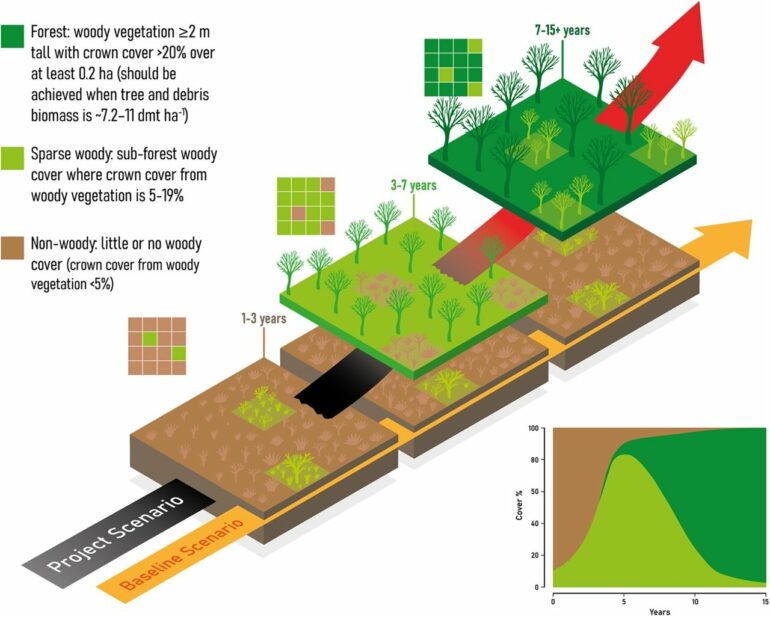Forest regeneration projects that have received tens of millions of carbon credits and dominate Australia’s carbon offset scheme have had negligible impact on woody vegetation cover and carbon sequestration, new research from The Australian National University (ANU) has found.
The research was undertaken in collaboration with Haizea Analytics, University of New South Wales (UNSW) and the University of Queensland, and analyzed 182 human-induced regeneration (HIR) projects. The findings are published in Communications Earth & Environment.
HIR projects are the world’s fifth largest nature-based offset type by credit issuances, and the largest when projects involving avoided emissions are excluded.
The analyzed projects are mostly located in dry outback areas in Queensland, New South Wales and Western Australia, and are being credited for regenerating native forests in areas that are largely uncleared.
The projects do not involve any tree planting. They are mainly claiming to regenerate native forests from soil seed stock, and suppressed seedlings, by reducing livestock and feral animal numbers.
The researchers say the projects have been controversial because decades of scientific research in Australia’s rangelands suggests grazing by livestock and feral animals generally does not have a material negative impact on woody vegetation cover.
The study assessed if woody vegetation cover increased in the ‘credited areas’ of the projects, where even-aged forests are supposed to be regenerating, and analyzed whether the trends in woody cover in the credited areas were materially different from those in comparison areas adjoining the project boundaries.
Professor Andrew Macintosh, from ANU, said the results suggest the projects have been “substantially over-credited and are largely failing.”
“The projects in the study received more than 27 million credits over the period of analysis and most of them claim regeneration started around 2010 to 2014,” he said.
“Due to this, their effects on woody vegetation cover should be very clear. But the data suggests tree cover has barely increased at all and, in many cases, it has gone backwards.
“Almost 80% of the projects experienced negative or negligible change in tree cover over the study period.
“The proportion of the total credited area, 3.4 million hectares, with woody cover increased by a mere 0.8% over this time.
“Forest cover—areas where the crowns of the trees cover is equal to or more than 20% of the area—increased by only 3.6%, while sparse woody cover—areas where the crowns of the trees cover between 5% and 19%—decreased by 2.8%.”
ANU Professor Don Butler, who led the statistical analysis in the study, said, “Not only were the changes in forest and sparse woody cover small, but they largely mirrored changes in the adjacent comparison areas, outside the projects.
“The results suggest the observed changes in woody vegetation cover are predominantly attributable to factors other than the project activities, most likely rainfall.”
The researchers say that a key problem with HIR projects is that sequestration is modeled, not directly measured. In addition, the model assumes even-aged forest regeneration is occurring across the entirety of the credited areas, regardless of what is happening on the ground.
Dr. Megan Evans from UNSW Canberra said, “HIR projects are credited on the basis that even-aged forest is regenerating across the entirety of the credited area and that, within approximately 10 to 15 years of when regeneration is modeled to have commenced, all of the credited area will have forest cover.
“The modest gain in woody cover observed within credited areas, and small effect of project registration on forest cover change, suggest this is unlikely to occur.
“The projects have largely failed to regenerate native forests and the evidence suggests things are unlikely to improve.
“Where carbon credits are issued to projects that do not sequester as much carbon as they are supposed to, it makes climate change worse. Credits from low integrity projects facilitate increases in emissions but the increases are not offset by reductions elsewhere.”
Professor David Eldridge from UNSW Syndey, who has spent years researching vegetation dynamics in the Australian outback, said, “The findings of the study should come as no surprise. They align perfectly with what decades of research in Australia’s rangelands suggests would occur.”
The researchers argue the findings highlight the practical limitations of offsets and the potential for offset schemes to credit abatement that is non-existent, non-additional and impermanent.
More information:
Andrew Macintosh et al, Australian human-induced native forest regeneration carbon offset projects have limited impact on changes in woody vegetation cover and carbon removals, Communications Earth & Environment (2024). DOI: 10.1038/s43247-024-01313-x
Provided by
Australian National University
Citation:
Forest regeneration projects failing to offset carbon emissions (2024, March 27)



